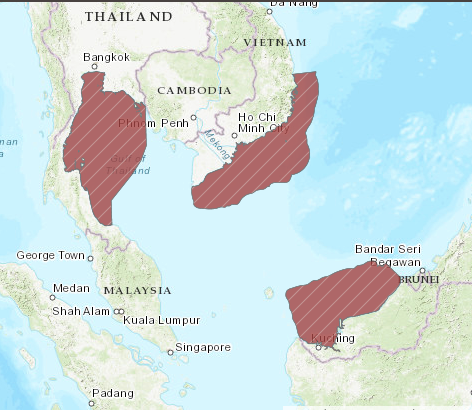The @IUCNRedList of Threatened Species has been updated today and includes recent assessments of 422 species of sharks and rays. One species in particular has a story that could serve as warning that we need to act fast to curb overfishing in time to save sharks & rays #Lostshark
The Lost Shark (Carcharhinus obsoletus) is the first shark to be assessed as Critically Endangered (Possibly Extinct) by the Global Shark Trends project and International Union for the Conservation of Nature’s Species Survival Commission’s Shark Specialist Group. @SSCmarine
The IUCN Guidelines (p. 81) caution that, “The category of Extinct is used when ‘there is no reasonable doubt that the last individual has died’. “However, extinction—the disappearance of the last individual of a species—is very difficult to detect... @IUCNRedList
…”Listing of a species as Extinct requires that exhaustive surveys have been undertaken in all known or likely habitat throughout its historical range, at appropriate times”...
…”Listing as Extinct has significant conservation implications, because protective measures and conservation funding are usually not targeted at species believed to be extinct …
…”Therefore, a species should not be listed in the Extinct (EX) or Extinct in the Wild (EW) categories if there is any reasonable possibility that they may still be extant, in order to avoid the ‘Romeo Error’ (Collar 1998)” @IUCNRedList @IUCNssc @IUCN
There are three reasons this species might be extinct, but there are three reasons why it might not, hence, this assessment is one of the first to apply the “Possibly Extinct” flag to a marine fish, based on the new Threats & Surveys assessment methods. https://www.iucnredlist.org/resources/ex-probability
The Lost Shark is a small requiem shark from the southern South China Sea (Gulf of Thailand, Viet Nam, and Sarawak in Malaysian Borneo) in the Western Central Pacific, but it may have had a wider historic distribution. #Lostshark
This species is known only from three type specimens recorded from fish landing sites and markets, the last of which was collected in 1934. That means that this species has not been observed for over 85 years.
The maximum size is unknown but, based on a closely related species, it likely reached a size of about 1 m total length. Like its relatives, it was probably found in shallow inshore coastal waters less than 50 m deep and, hence, is unlikely to have any depth refuge from fisheries
There is considerable passive surveillance in the region by the scientific community which might have a low chance of detecting and identifying this species, if present. #Lostshark
Further, what gives confidence that this species is possibly extinct is that there have been at least five directed surveys by taxonomists with the knowledge and expertise to identify it if sampled and found.
While the taxonomists did not yet have a name for the species, they have been aware of an undescribed requiem shark for nearly half a century and have been looking for it since the late 1970s. Hence the common name 'Lost Shark’. https://doi.org/10.1371/journal.pone.0209387 @WillWhitesharks
It is too soon to say that this species is Extinct and will never be found again. We caution that there are two other similar species that have been rediscovered long after the last specimens were collected. #Lostshark #Foundshark
The last specimen of the Borneo Shark (Carcharhinus borneensis) was collected in 1937 but was recently rediscovered in Borneo in 2004. #Lostshark #Foundshark @WillWhitesharks https://tinyurl.com/yyflk39j
The Smoothtooth Blacktip Shark (Carcharhinus leiodon) was known only from one specimen collected in 1907 but was subsequently rediscovered in 2009. #Lostshark #Foundshark @AlecBMMoore https://www.publish.csiro.au/mf/mf10159
The assessment was based partly on the suspicion that the species had undergone a population reduction of >99.9%, 96% and 82% in Thailand, Viet Nam and Sarawak, respectively, based on reconstructed catches. @SeaAroundUs
Intense fisheries have been developing for over a century, with industrial fisheries expanding in the 1960s and have been operating for more than 60 years (6.6 generation lengths). #Lostshark
The The probability that the species was extinct was estimated using newly developed Threats and Survey models. @stubutchart @IUCNRedList @IUCNssc @SSCmarine #Lostshark https://www.iucnredlist.org/resources/ex-probability
As a result of the long duration and severity of threats, the chance of extinction according to the Threat model is very high (0.9), while the low level of directed search and survey effort leads to a lower probability of extinction (0.36) according to the Survey model.
This new finding underscores the need for massive improved and expanded monitoring in SE Asia to support fisheries monitoring, assessment and management of all exploited species. There is clearly a need to control fishing effort to levels that can support sustainable fisheries.
This assessment cautions that iconic sharks and rays could be sliding toward extinction unnoticed. The Global Shark Trends project recently assessed the status of all sharks, rays and ghost sharks in the SE Asia region and we will be able to provide a fuller update next year.
You can find the whole assessment here: https://www.iucnredlist.org/species/115696622/115696628
#Lostshark
#Lostshark

 Read on Twitter
Read on Twitter



